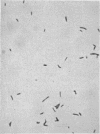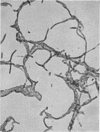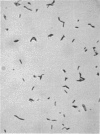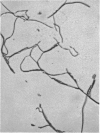Abstract
The effect of xanthines on various microorganisms was studied. The antibacterial effect was not high; most of the test organisms could easily withstand a concentration of 2,500 μg/ml. Caffeine was more antibacterial than theophylline, and the latter more than theobromine. Caffeine citrate exhibited greater inhibitory effect than did pure caffeine. The effect was both bacteriostatic and bactericidal against susceptible organisms. The susceptibility of organisms to xanthines differed greatly even in related species. The morphology of Aerobacter aerogenes and A. cloacae was affected under the influence of caffeine; filamentation of cells followed sublethal doses. Potentiation was seen with antibiotics and caffeine; resistant strains were killed with a lower dose of drug in the presence of caffeine. This potentiating effect was pronounced with the tetracyclines; with streptomycin, the effect was the contrary.
Full text
PDF




Images in this article
Selected References
These references are in PubMed. This may not be the complete list of references from this article.
- DONESON I. N., SHANKEL D. M. MUTATIONAL SYNERGISM BETWEEN RADIATIONS AND METHYLATED PURINES IN ESCHERICHIA COLI. J Bacteriol. 1964 Jan;87:61–67. doi: 10.1128/jb.87.1.61-67.1964. [DOI] [PMC free article] [PubMed] [Google Scholar]
- HENIS Y., TAGARI H., VOLCANI R. EFFECT OF WATER EXTRACTS OF CAROB PODS, TANNIC ACID, AND THEIR DERIVATIVES ON THE MORPHOLOGY AND GROWTH OF MICROORGANISMS. Appl Microbiol. 1964 May;12:204–209. doi: 10.1128/am.12.3.204-209.1964. [DOI] [PMC free article] [PubMed] [Google Scholar]
- NOVICK A., SZILARD L. Experiments on spontaneous and chemically induced mutations of bacteria growing in the Chemostat. Cold Spring Harb Symp Quant Biol. 1951;16:337–343. doi: 10.1101/sqb.1951.016.01.025. [DOI] [PubMed] [Google Scholar]






